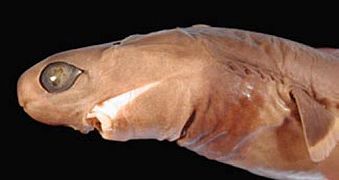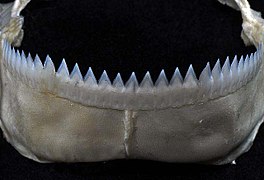COOKIECUTTER SHARKS
BEASTLY LITTLE SUCKERS
The Cookiecutter shark Isistius brasiliensis (aka the less scary, more genial sounding ‘cigar shark’), might be an ideal candidate for a Room 101 nemesis.** These little beasts – a species of dogfish shark – are found in several mainly island-based areas dotted around the globe, including in Bahamas waters.


HORRIFYING COOKIECUTTER FACTS
- Live in the depths, rise vertically in the day & dive back down at dusk
- Undersides have light-emitting ‘photophores’ which emphasise…
- …the dark collar which acts as a lure, resembling a small innocent fish
- Bioluminescence lures prey & confuses predators (more on this below)
- The glow is so strong it may last for some time after removal from water

- Their lips are ‘suctorial’ = they attach tightly to their target
- The jaws then gouge out the victim’s flesh in a remarkably neat circle
- Omni-vicious: any medium to large ocean creature is vulnerable to attack
- There are even occasional reports of humans being targeted

Here are two Blainville’s beaked whales that I photographed from the BMMRO research vessel. The top whale has a number of circular healed attack marks and a recent one. You can see how deep the gouged hole is. The other has well-healed scars.
- Multi-toothed: top rows of small teeth, rows of larger teeth on the bottom
- The lower teeth are the cutters, acting like a saw when locked on
- See header image and below for full details




ARE THESE SHARKS ‘PARASITES’, WOULD YOU SAY?
The behaviour of these sharks is an example of a symbiotic relationship between two species that is parasitic. This means essentially that one gains and the other suffers (eg humans & no-see-ums). This is distinct from commensalistic symbiosis, where one species gains and the other is unaffected (e.g. cattle egrets with cattle); and mutualistic symbiosis, where both gain (e.g. cleaner fish & groupers). So, in a word, yes.

- An ‘ambush predator’: these little sharks ‘hover’ in the water column waiting…
-
They are capable of rapid movement to catch up & latch onto prey
-
They will eat a passing small fish, crustacean or even squid as a snack
- Sometimes they operate in schools; there is safety in numbers
- The schools are thought to increase the ‘lure’ effect of the dark collar
A beached whale that’s been heavily targeted
FUN FACT TO COUNTERACT THE BAD STUFF
In the late c20, more than 30 U.S. Navy submarines were forced back to base to repair damage caused by cookiecutter shark bites, either to the neoprene footings of sonar domes or to rubber-sheathed cables. The problems were solved by using fibreglass. Oceanographic equipment and telecommunications cables are also recorded as being damaged by these sharks.
Cookiecutter Shark – the real deal 
MONSTERS OF THE DEEP
These great cards from the weirdly spelled WIERD ‘N’ WILD CREATURES provide excellent factual info. Their CCS card is no exception. You’ll find more details here about the effect of the bioluminescence and so on, written as clearly as I might hope to.
** “The worst thing in the world varies from individual to individual. It may be burial alive or death by fire, or by drowning, or by impalement, or fifty other deaths. There are cases where it is some quite trivial thing, not even fatal.” (George Orwell, 1984). Being in a tank with some cookiecutters might count.
Alright now… the wounds eventually heal
Credits: BMMRO – header image; beaked whale photos – Keith Salvesen / BMMRO; Te Ara NZ for the main jaw image; all small images with thanks to Wiki and respective photographers who took the time to upload them for all to enjoy & learn from; ‘wierdnwonderful creatures’ for the monster card; range map from Wiki









You must be logged in to post a comment.